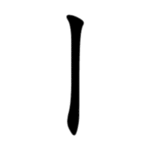Radical 2
Radical 2 or radical line (丨部) meaning "vertically connected"[1] is one of 6 of the 214 Kangxi radicals that are composed of only one stroke.
| 丨 | ||
|---|---|---|
| ||
| 丨 (U+4E28) "line, stick" | ||
| Pronunciations | ||
| Pinyin: | gǔn | |
| Bopomofo: | ㄍㄨㄣˇ | |
| Gwoyeu Romatzyh: | goen | |
| Wade–Giles: | kun3 | |
| Cantonese Yale: | kwan2 | |
| Jyutping: | gwan2 | |
| Pe̍h-ōe-jī: | khún | |
| Japanese Kana: | コン kon (on'yomi) ぼう bō (kun'yomi) | |
| Sino-Korean: | 곤 gonn | |
| Names | ||
| Chinese name(s): | 豎/竖/竪 shù | |
| Japanese name(s): | 棒/ぼう bō (stick) 縦棒/たてぼう tatebō (vertical stick) | |
| Hangul: | 뚫을 tturheul | |
| Stroke order animation | ||
 | ||
In the Kangxi Dictionary, there are only 21 characters (out of 49,030) to be found under this radical.
丨 is also the 2nd indexing component in the Table of Indexing Chinese Character Components predominantly adopted by Simplified Chinese dictionaries published in mainland China.
Evolution
 Large seal script character
Large seal script character Small seal script character
Small seal script character
Derived characters
| Strokes | Characters |
|---|---|
| +0 | 丨 |
| +1 | 丩 |
| +2 | 个SC/variant (=個 -> 人) 丫 |
| +3 | 中 丮 丯 丰SC/JP/丰TC (also SC/JP form of 豐 -> 豆) 书SC (=書 -> 曰) |
| +4 | 丱 |
| +6 | 串 |
| +7 | 丳 |
| +8 | 临SC (=臨 -> 臣) |
| +9 | 丵 |
In calligraphy

The vertical line as in 永
The only stroke in radical line, known as 豎/竖/竪 shù "vertical", is called 努 nǔ in the eight principles of the character 永 (永字八法 Yǒngzì Bāfǎ) which are the basis of Chinese calligraphy.
Literature
- Fazzioli, Edoardo (1987). Chinese calligraphy : from pictograph to ideogram : the history of 214 essential Chinese/Japanese characters. calligraphy by Rebecca Hon Ko. New York: Abbeville Press. ISBN 0-89659-774-1.
- Leyi, Li (1993). Tracing the Roots of Chinese Characters: 500 Cases. Beijing. ISBN 978-7-5619-0204-2.
References
- 《說文解字》:“丨,上下通也。” Shuowen Jiezi: "丨" means vertically connected.
This article is issued from Wikipedia. The text is licensed under Creative Commons - Attribution - Sharealike. Additional terms may apply for the media files.
